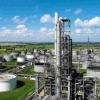Normal operating liquid in a pump suction line taking suction from a vessel is 790 kg/m3. If the suction piping has to undergo hydrotest should it be designed taking water density of 1000 kg/m3
|
|
Design Pressure Of Pump Suction Line
Started by ayan_dg, Apr 29 2009 03:56 AM
3 replies to this topic
Share this topic:
#1

Posted 29 April 2009 - 03:56 AM
#2

Posted 29 April 2009 - 05:07 AM
Ayan:
You normally hydrotest a piece of equipment in accordance with its normal operating pressure. The hydraulic pressure applied to the equipment is usually 1.5 times greater than its operating pressure.
The fact that you will be pumping a liquid other than water through the pipe has no relationship with the pressure applied with water. It's the same reference pressure, regardless of what liquid you pump or what liquid is used to apply the hydraulic pressure during the hydrotest.
You could hydrotest the pipe with oil if you wanted to; the results of the hydrotest, at the same pressure, would be just as correct as with water.
Now it is my turn to query you: Why do you ask the question? Do you believe/suspect that the results would be different? If so, what is the reason for your doubt or suspicion? Do you know the purpose of the hydrotest and what you are trying to do with it?
#3

Posted 29 April 2009 - 05:30 AM
Hydrotest pressure is 1.3 times design pressure. For a vessel ,normally we will specify top RV set pressure . The pressure at the bottom of thevessel will be RV set pressure + static height of the liquid. If the liquid is more dense the pressure at the bottom will be higher. so for water we will get a higher pressure at the bottom than oil.
#4

Posted 30 April 2009 - 09:26 AM
QUOTE (ayan_dg @ Apr 29 2009, 12:56 AM) <{POST_SNAPBACK}>
If the suction piping has to undergo hydrotest
ayan,
Art was misled into thinking you were hydrotesting piping and not a pressure vessel. That is exactly what you imply in the above statement. For a pressure vessel, the design pressure is defined at the top of the vessel (which is above the liquid level unless the vessel is liquid full). The bottom of the vessel will "see" the applied hydrotest pressure plus the static head of the test fluid (typically water). The vessel designer knows this, and the vessel should be able to easily handle the hydrostatic test condition. Despite this, I would want to confirm the above statements with the vessel designer, just because I'm very particular about such things. If you are talking about a large vertical vessel, such as a distillation column, special considerations may be important. Perhaps the most important thing to note is that the column's supports are unlikely to be able to support a water filled column. Experienced construction personnel would be thoroughly familiar with such facts and would know that the vessel would not be tested in situ.
Similar Topics
Lng Boil Off Gas Compressor Suction DrumStarted by Guest_Lyne_* , 04 Jun 2025 |
|

|
||
Steam Pressure In Heat ExchangerStarted by Guest_mvanrijnbach_* , 15 Apr 2025 |
|

|
||
Scrubber DesignStarted by Guest_nasss_* , 07 Aug 2024 |
|

|
||
Ammonia Line Vapor GenerationStarted by Guest_simadri_* , 07 Apr 2025 |
|

|
||
Thermal Oil Pump Motors Blew OffStarted by Guest_lizelle_* , 02 May 2025 |
|

|

 FB
FB








